Villager (old)
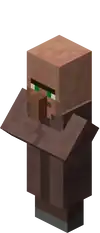
Adult
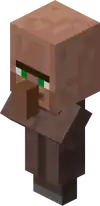
Baby
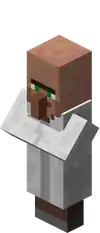
Adult
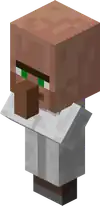
Baby
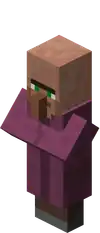
Adult
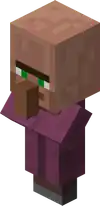
Baby
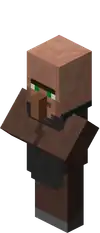
Adult
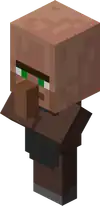
Baby
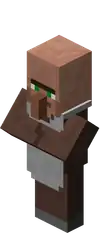
Adult
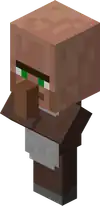
Baby
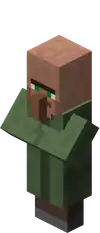
Adult
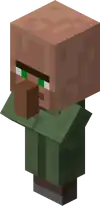
Baby
| Health points |
20HP × 10 |
|---|---|
| Behavior |
Passive |
| Mob type |
NPC[note 1] |
| Hitbox size |
Adult: |
| Spawn |
{
"title": "Villager",
"rows": [
{
"field": "20<span class=\"hidden-alt-text\">HP</span><span class=\"nowrap mc-hearts\"><span class=\"iconbar pixel-image nowrap\" style=\"--icon-offset:-1px;\" title=\"1 heart\">(link to File:Heart (icon).png article, displayed as 9px|link=|alt=♥)</span> × 10</span><br>0<span class=\"hidden-alt-text\">HP</span><span class=\"nowrap mc-hearts\"><span class=\"iconbar pixel-image nowrap\" style=\"--icon-offset:-1px;\" title=\"0 hearts\">(link to File:Empty Heart (icon).png article, displayed as 9px|link=|alt=♥)</span></span> (if spawned by spawn egg)<sup class=\"noprint nowrap Inline-Template \" title=\"\">[<i><span title=\"This statement only applies to Bedrock Edition and Minecraft Education\">(link to Bedrock Edition article, displayed as BE) & (link to Minecraft Education article, displayed as edu) only</span></i>]</sup>",
"label": "(link to Health article, displayed as Health points)"
},
{
"field": "Passive",
"label": "Behavior"
},
{
"field": "NPC",
"label": "(link to Mob article, displayed as Mob) type"
},
{
"field": "'''Adult:'''<br>Height: 1.95 Blocks<br>Width: 0.6 Blocks<br>\n'''Baby:'''<br>Height: 0.975 Blocks<br>Width: 0.3 Blocks",
"label": "(link to Hitbox article, displayed as Hitbox size)"
},
{
"field": "(link to #Spawning article, displayed as see §Spawning)",
"label": "(link to Mob spawning article, displayed as Spawn)"
}
],
"invimages": [],
"images": [
"Farmer.png",
"Baby Farmer BE.png",
"Librarian.png",
"Baby Librarian BE.png",
"Priest.png",
"Baby Priest BE.png",
"Blacksmith.png",
"Baby Blacksmith BE.png",
"Butcher.png",
"Baby Butcher BE.png",
"Nitwit.png",
"Baby Nitwit BE.png"
]
}
Villagers are passive mobs that inhabit villages, work at their professions, breed, and interact with each other. Their clothing varies according to their occupation. A player can trade with villagers, using emeralds as currency. Villagers received a complete overhaul of both their appearance and their functionality in the Village & Pillage update; this page covers villagers as they appeared and behaved before the update.
Spawning
Spawn eggs
In Bedrock Edition, the old villager spawn egg can still be obtained by /give @s spawn_egg 1 15, but it spawns a new villager instead.
In older versions, it would spawn an old villager and immediately kill it, replacing it with a new villager.
Natural generation
In Java Edition, old villagers can only spawn in versions of Minecraft prior to 1.14. In Bedrock Edition, old villagers can only spawn if they existed from a template world prior to 1.11.0, and any old villager spawned after 1.11.0 outside a template world is converted into villager_v2.
Baby villagers
Villagers breed autonomously, but need doors and need to be willing in order to spawn baby villagers. After exactly 20 minutes during which the baby villager is within render distance, the baby villager grows up to an adult. See this section for more information.
Curing
Villagers spawn if a player uses a splash potion of weakness on a v1 zombie villager in template world and then feeds it a regular golden apple. It then shakes and turn into a villager within 0-5 minutes. During the change, the zombie villager can still burn in the sun.
Drops
Villagers drop nothing upon death.
Trade: 3–6 xp Trade while willing: 8–11 xp
Behavior
Movement patterns
Upon spawning, villagers leave their homes and begin to explore the village. Generally, they wander aimlessly inside the village during the day. They may go indoors or outdoors, and they periodically make mumbling sounds. Occasionally, two villagers may stop and turn to look at each other, in a behavior called socializing, in which they stare at another villager for 4-5 seconds at a time. In the case of players, they continuously stare at them as long as the player is close enough, unless the villager tries to get into a house at night, farm food, or flee from a zombie.
In Legacy Console Edition, when a player attacks a villager, the villager does not run away, but anger particles fly out from the villager if it is in a village. In Bedrock Edition, villagers do not stop continuously in front of players. They also sprint away if the player attacks them.
Villagers, like other mobs, find paths around obstructions, avoiding walking off cliffs and some blocks that cause harm. However, in crowded situations it is possible for one villager to push another off a cliff or into harm. Villagers also occasionally walk off of ledges high enough to cause fall damage.
At night or during rain, villagers run inside, closing doors behind them, and staying indoors until morning. In the morning they head outside and resume normal behavior.
Villagers flee from zombies, illagers and vexes within 8 blocks.
If a villager finds itself outside the village boundary, or a villager without a village detects a village boundary within 32 blocks, it moves quickly back within the boundary. A villager taken more than 32 blocks away from its village boundary forgets the village within about 6 seconds. Whether in a village or not, a villager is never prone to despawning.
Villagers cannot open trapdoors, fence gates, or iron doors.
There is evidence that villagers are prone to overcrowding certain areas of a village while leaving other areas completely empty. When moving inside, the AI prefers doors within 16 blocks (Euclidean distance). It also tends to prefer doors with fewer villagers nearby, however "nearby" in this case is only 1.5 blocks and, when moving inside, villagers prefer to move 2.5 blocks inside when the inside is to the south or east and therefore go out of range of this check. During the day, it has been observed that villagers tend to cluster near a trapped villager or any existing large cluster of villagers, likely due to the "socialize" AI routine overriding their inclination to wander.
Picking up items
Villagers have eight hidden inventory slots, which start empty whenever the villager is spawned. Villagers do not intentionally seek out items to pick up, but they collect any bread, carrots, potatoes, wheat, seeds, beetroot and beetroot seeds they happen to come within range of. These are the only items they are able to pick up, though the player may use the /replaceitem command to put an arbitrary item into a villager's inventory. If a player and a villager are in the pickup range of an item at the same time, the player always picks it up first.
Even when gamerule keepInventory is set to false, villagers that are killed with any of the available items above do not drop them once they are killed.
Any items in these slots are lost if a villager becomes a zombie villager; a zombie villager has no inventory slots.
If /gamerule mobGriefing is false, villagers do not pick up items.
A dispenser can be used, if adjacent to a villager, to place armor on it. While not visible in most cases (other than pumpkins and mob heads) the equipment is fully functional; for example, the Thorns enchantment hurts zombies that attack a villager with a piece of armor enchanted with the Thorns enchantment equipped.
Sharing food
If a villager has enough food in one inventory stack (6 bread or 24 carrots, potatoes, beetroots, or 18 wheat for farmers only) and sees a villager without enough food in one inventory stack (3 bread or 12 carrots, potatoes or beetroot for non-farmers; 15 bread, 60 carrots, potatoes, or beetroot, or 45 wheat for Farmers), the villager may decide to share food with that villager.
To share, a villager finds its first inventory stack with at least 4 bread, carrots, potatoes, or beetroot or with at least 6 wheat, and then throws half the stack (rounded down) in the direction of the target villager. When wheat is shared, it is first crafted to bread which may result in 1 or 2 less than half the stack being shared.
Farming
Adult and baby brown-robed villagers, both farmers and other careers, tend crops within the village boundary. Villagers far enough outside the boundary of any village also tend nearby crops.
Farmland to be tended is found by seeking for certain blocks up to 15 blocks away from the villager in X and Z and up to 1 away in Y (a 31×31×3 area total).
- If a brown-robed villager does not have enough food in one stack in its inventory (15 bread, 60 carrots, potatoes, or beetroot, or 45 wheat) and finds fully-grown wheat, carrots, potatoes or beetroot, it moves to the crop block and break it.
- If a brown-robed villager has any seeds, carrots, potatoes, or beetroot seeds in its inventory and finds an air block above farmland, it moves to it and plant a crop. They always plant from the first eligible slot in their inventory.
- If
/gamerule mobGriefingisfalse, villagers cannot farm.
Baby villager behavior
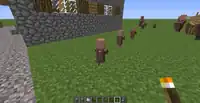
Baby villagers sprint around, entering and leaving houses randomly. They sometimes stop sprinting to stare at an iron golem. If the iron golem is holding a poppy, it might attract any baby villagers near it.
Baby villagers in Bedrock/Legacy Console Editions have a slightly bigger head than in the Java Edition, this also can be seen in different baby mobs in the game as well.
Unlike other breed-able mobs, the parents and child have no personal interactions other than socializing.
Zombies
Zombies try to find and attack villagers within a 42 block radius (even when the villager is invisible), and attempt to break down doors. Zombies successfully break doors only if the difficulty is set to hard, although only a fraction of zombies spawned in Hard mode have the capacity to break doors. This also applies to zombie pigmen if they path find through a door. Villagers flee from zombies, sometimes hiding in houses. The villager's only "natural" defense are the iron golems, which attack nearby hostile mobs.
Zombies try to kill villagers, or convert them to v1 zombie villagers. The chance for a villager to become a zombie villager on death is 0% on Easy, 50% on Normal, and 100% on Hard. Baby villagers can be infected by zombies as well.
Villagers also flee from zombie pigmen, although the latter do not attack them.
Drowned chase and attack villagers in the same way as zombies, and villagers run from drowned in the same way they run from zombies. Drowned can also convert villagers to zombie villagers, even when attacking from a distance with a trident.
Lightning
When lightning strikes within 3–4 blocks of a villager, it turns into a witch.
Breeding
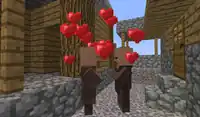
Villagers mate depending on the number of valid doors. If "willing" (see below), villagers mate as long as the population is less than 35% (Bedrock Edition: 100%) of valid doors, rounded down. The type of villager that spawns is independent of the villager's parents.
A valid door is any door within the village radius where the number of "outside" spaces within 5 blocks in a straight line on one side of the door is not the same as the number of "outside" spaces within 5 blocks on the other side of the door. A space is considered to be "outside" if it has nothing but transparent blocks above it all the way to the sky.
A census is periodically taken to determine the current population of the village. All villagers within the horizontal boundary of the village and within 5 vertical blocks (Bedrock Edition: no apparent height limit) of the center is counted as part of the population to determine if continued villager mating is allowed. However, any villager within the horizontal boundary of the village and within the spherical boundary of the village attempts to enter mating mode as long as there is at least one villager within the boundary. If two villagers simultaneously enter mating mode while they are close to one another, they mate with each other and produce a child.
Willingness
Additionally, villagers must be "willing" in order to breed. After mating, they are no longer willing, and must be made willing again.
Villagers can become willing by having either 3 bread, 12 carrots, 12 potatoes, or 12 beetroots in one stack in their inventory. Any villager with an excess of food (usually farmers) throw food to other villagers, allowing them to pick it up and obtain enough food to become willing. The player can also throw bread, carrots, beetroots, or potatoes at the villagers themselves to encourage breeding. Villagers consume the required food upon becoming willing.
Villagers may also become willing when the player trades with them. Willingness is granted the first time a new offer is traded, or at a one-in-five chance on subsequent trades. Most of the time, villagers becomes willing after the second or third trade. Green particles appear if the villager becomes willing by trading. This does not cause them to immediately seek out a mate, however.
Before Java Edition 1.8, willingness was not implemented. The only factor needed is enough valid doors.
Professions and careers
Each villager has a profession, which can be identified by their clothing. Villagers also have careers specific to their profession. The player can identify a villager's career by reading the title at the top of the trading interface.
Below is a table listing the various villagers, with their careers in relation to their professions, as well as the IDs specifying these. While each profession has a 1 in 6 chance (16.67%) of occurring, the probabilities for individual careers to occur are more diversified. They are listed in the table as well.
| Clothing | Profession | Profession ID | Career | Career ID | Probability | Combined Probability |
|---|---|---|---|---|---|---|
| Farmer | 0 | Farmer | 1 | 1⁄24 (4.17%) | 1⁄6 (16.67%) | |
| Fisherman | 2 | 1⁄24 (4.17%) | ||||
| Shepherd | 3 | 1⁄24 (4.17%) | ||||
| Fletcher | 4 | 1⁄24 (4.17%) | ||||
| Librarian | 1 | Librarian | 1 | 1⁄12 (8.33%) | 1⁄6 (16.67%) | |
| Cartographer | 2 | 1⁄12 (8.33%) | ||||
| Priest/Cleric | 2 | Cleric | 1 | 1⁄6 (16.67%) | 1⁄6 (16.67%) | |
| Blacksmith | 3 | Armorer | 1 | 1⁄18 (5.56%) | 1⁄6 (16.67%) | |
| Weapon Smith | 2 | 1⁄18 (5.56%) | ||||
| Tool Smith | 3 | 1⁄18 (5.56%) | ||||
| Butcher | 4 | Butcher | 1 | 1⁄12 (8.33%) | 1⁄6 (16.67%) | |
| Leatherworker | 2 | 1⁄12 (8.33%) | ||||
| Nitwit | 5 | Nitwit | 1 | 1⁄6 (16.67%) | 1⁄6 (16.67%) |
When a villager is transformed into a zombie villager, the profession of the zombie villager remains unchanged. However, the career is reset and randomly picked again if the zombie villager is cured, allowing for the player to get a villager with a new career and new trade offers. Old trade offers disappear, even if the same career is chosen again.
Nitwit

|
“ |
|
„ |
| — Jeb about the Nitwit[1] |
The nitwit villager is a villager that wears a green robe and cannot be traded with.
Trading
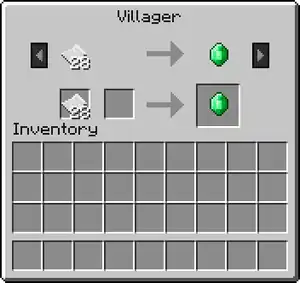

|
“ |
|
„ |
| — Marsh Davies[2] |
The trading system is a gameplay mechanic that allows players to trade emeralds for items and vice-versa with villagers. Their trades can be good or bad, depending on what the cost is and what items you might get. Trading is only available for adult villagers; the player cannot trade with baby villagers or the nitwit villager.
Right-clicking a villager allows a player to trade with them, and display their career. Villagers make offers based on their profession and career, and trade based on whatever offers they are making. Different offers may be viewed by pressing the left and right buttons next to the currently displayed offer. All offers involve emerald as a currency, and some item pertinent to the villager's profession and career. Trading allows the acquisition of rare items that would otherwise be fairly difficult to obtain, such as chain armor. The trading mechanic allows players to get bottle o' enchanting in survival mode. When villagers get a new trade, pink particles and green cross particles appear.
After trading a new offer once, the villager allows a new tier of offers. After 2-12 times an offer is repeated, the villager locks the trade offer. That is, the villager no longer offers this trade. When this happens, the player must use another new trade offer in the villager's window once (or several times if it is already used once), and then wait for a short time. If green particles appear, all trades unlock. That is, the villager starts offering all trades. There is a maximum number of tiers each villager can possess, varying by career. Once the villager has unlocked all tiers, it does not open any new ones. However, players can still renew all offers by trading.
Regeneration
When a villager gives off particles from a new trade, they get 10 seconds of Regeneration I, which gives them 4HP.
Commands or external editors can help villagers get new trades.
If a villager unintentionally picks up certain seeds or crops, it throws it to another villager to simulate trading between the villagers.
Sounds
Java Edition:
Villagers used the Friendly Creatures sound category for entity-dependent sound events.
| Sounds | ||||||||
|---|---|---|---|---|---|---|---|---|
| Sound | Subtitles | Source | Description | Resource location | Translation key | Volume | Pitch | Attenuation distance |
| Villager mumbles | Friendly Mobs | Randomly | entity | subtitles | 1.0 | 0.8-1.2 (Baby: 1.3-1.7) | 16 | |
| Villager dies | Friendly Mobs | When a villager dies or becomes zombified | entity | subtitles | 1.0 | 0.8-1.2 (Baby: 1.3-1.7) | 16 | |
| Villager hurts | Friendly Mobs | When a villager is damaged | entity | subtitles | 1.0 | 0.8-1.2 (Baby: 1.3-1.7) | 16 | |
| Villager agrees | Friendly Mobs | When a player successfully trades with a villager and when a player gives a villager an sufficient amount of resources | entity | subtitles | 1.0 | 0.8-1.2 (Baby: 1.3-1.7) | 16 | |
| Villager disagrees | Friendly Mobs | When a player gives a villager an insufficient amount of resources | entity | subtitles | 1.0 | 0.8-1.2 (Baby: 1.3-1.7) | 16 | |
| Villager trades | Friendly Mobs | Randomly while the trade UI on a villager is open | entity | subtitles | 1.0 | 0.8-1.2 (Baby: 1.3-1.7) | 16 | |
| Sounds | |||||
|---|---|---|---|---|---|
| Sound | Source | Description | Resource location | Volume | Pitch |
| Friendly Creatures Friendly Mobs | Randomly | mob | 1.0 | 0.8-1.2 | |
| Friendly Creatures Friendly Mobs | When a villager dies or becomes zombified | mob | 1.0 | 0.8-1.2 | |
| Friendly Creatures Friendly Mobs | When a villager is damaged | mob | 1.0 | 0.8-1.2 | |
| Friendly Creatures Friendly Mobs | When a player successfully trades with a villager | mob | 1.0 | 0.8-1.2 | |
| Friendly Creatures Friendly Mobs | When a player successfully trades with a villager | mob | 1.0 | 0.8-1.2 | |
| Friendly Creatures Friendly Mobs | Unused sound event[sound 1] | mob | 1.0 | 0.8-1.2 | |
| Friendly Creatures Friendly Mobs | When a trade UI on a villager is opened | mob | 1.0 | 0.8-1.2 | |
Data values
ID
| Name | Identifier | Translation key |
|---|---|---|
villager | entity |
| Name | Identifier | Numeric ID | Translation key |
|---|---|---|---|
villager | 15 | entity |
Entity data
Villagers have entity data associated with them that contains various properties.
- [NBT Compound / JSON Object] Entity data
- Tags common to all entities see Template:Nbt inherit/entity/template
- Tags common to all mobs see Template:Nbt inherit/mob/template
- Additional fields for mobs that can breed see Template:Nbt inherit/breedable/template
- [Int] Profession: The ID of the texture used for this villager. This also influences trading options.
- [Int] Riches: Currently unused. Increases by the number of emeralds traded to a villager any time they are traded.
- [Int] Career: The ID of this villager's career. This also influences trading options and the villager's name in the GUI (if it does not have a CustomName). If 0, the next time offers are refreshed, the game assigns a new Career and resets CareerLevel to 1.
- [Int] CareerLevel: The current level of this villager's trading options. Influences the trading options generated by the villager; if it is greater than their career's maximum level, no new offers are generated. Increments when a trade causes offers to be refreshed. If 0, the next trade to do this assigns a new Career and sets CareerLevel to 1. Set to a high enough level causes no new trades to release (Career must be set to 1 or above).
- [Byte] Willing: 1 or 0 (true/false) - true if the villager is willing to mate. Becomes true after certain trades (those which would cause offers to be refreshed), and false after mating.
- [NBT List / JSON Array] Inventory: Each compound tag in this list is an item in the villager's inventory, up to a maximum of 8 slots. Items in two or more slots that can be stacked together are automatically condensed into one slot. If there are more than 8 slots, the last slot is removed until the total is 8. If there are 9 slots but two previous slots can be condensed, the last slot remains after the two other slots are combined.
- [NBT Compound / JSON Object] An item in the inventory, excluding the Slot tag.
- A single item stack see Template:Nbt inherit/itemnoslot/template
- [NBT Compound / JSON Object] An item in the inventory, excluding the Slot tag.
- [NBT Compound / JSON Object] Offers: Is generated when the trading menu is opened for the first time.
- [NBT List / JSON Array] Recipes: List of trade options.
- [NBT Compound / JSON Object] A trade option.
- [Byte] rewardExp: 1 or 0 (true/false) - true if this trade provides XP orb drops. All trades from naturally-generated villagers in Java Edition reward XP orbs.
- [Int] maxUses: The maximum number of times this trade can be used before it is disabled. Increases by a random amount from 2 to 12 when offers are refreshed.
- [Int] uses: The number of times this trade has been used. The trade becomes disabled when this is greater or equal to maxUses.
- [NBT Compound / JSON Object] buy: The first 'cost' item, without the Slot tag.
- A single item stack see Template:Nbt inherit/itemnoslot/template
- [NBT Compound / JSON Object] buyB: May not exist. The second 'cost' item, without the Slot tag.
- A single item stack see Template:Nbt inherit/itemnoslot/template
- [NBT Compound / JSON Object] sell: The item being sold for each set of cost items, without the Slot tag.
- A single item stack see Template:Nbt inherit/itemnoslot/template
- [NBT Compound / JSON Object] A trade option.
- [NBT List / JSON Array] Recipes: List of trade options.
Achievements
| Icon | Achievement | In-game description | Actual requirements (if different) | Gamerscore earned | Trophy type (PS) | ||
|---|---|---|---|---|---|---|---|
| PS4 | Other | ||||||
| The Haggler | Acquire or spend 30 Emeralds by trading with villagers or with wandering trader. [sic] | — | 30 | Silver | |||
| Treasure Hunter | Acquire a map from a cartographer villager, then enter the revealed structure | Visit the structure indicated while the purchased map is in your main hand (hotbar). | 40 | Silver | |||
Advancements
| Icon | Advancement | In-game description | Actual requirements (if different) |
|---|---|---|---|
 | A Throwaway Joke | Throw a Trident at something. Note: Throwing away your only weapon is not a good idea. | Hit a mob with a thrown trident. |
 | Take Aim | Shoot something with an Arrow | Using a bow or a crossbow, shoot a mob with an arrow, tipped arrow, or spectral arrow. |
 | Very Very Frightening | Strike a Villager with lightning | Hit a villager with lightning created by a trident with the Channeling enchantment, turning it into a witch. |
 | What a Deal! | Successfully trade with a Villager | Take an item from a villager or wandering trader's trading output slot. |
History
| Java Edition | |||||||
|---|---|---|---|---|---|---|---|
| 1.0.0 | Beta 1.9 Prerelease | ||||||
| Villagers share the same AI as pigs. | |||||||
| Villagers have the name "TESTIFICATE" displayed over their heads as player names are displayed in multiplayer. | |||||||
| Villages have 5 main professions (0, 1, 2, 3, 4), and other profession numbers were a green-robed unnamed villager. | |||||||
| "We added them in 2011, but in the beginning they were completely useless - you couldn't trade with them, they didn't have any sound effects or anything. Their only purpose was to live in the villages. We discussed a lot about what they would do - we knew we wanted trading, but we weren't sure about what would happen with the village itself. Would the player do quests around the village? Would it expand?" – Jeb[2] | |||||||
| Beta 1.9 Prerelease 2 | The "TESTIFICATE" name above villager's heads has been removed. | ||||||
| 1.1 | 11w49a | Added the villager spawn egg to Creative mode. However, only farmer villagers are spawned. | |||||
| 1.2.1 | 12w05a | Villagers now go inside at night and detect houses. | |||||
| Villagers can now open and close doors. | |||||||
| 12w06a | Villagers can now socialize with each other and passive mobs. | ||||||
| Villagers are now attacked by and run away from zombies. | |||||||
| Villagers now go inside shelter whenever it rains. | |||||||
| 12w07a | |||||||
| Villagers now repopulate villages by the number of houses there are. | |||||||
| Villager children now sprint. | |||||||
| 1.3.1 | 12w18a | Villagers spawned via a spawn egg now have a random profession. | |||||
| 12w21a | Added trading with villagers. Leaving a trading window open causes villagers not to wander under normal circumstances. | ||||||
| 12w22a | Villagers now reassign their profession if there is a lack of a specific profession or if the number of villagers in a profession is unbalanced (i.e., if there are many farmer villagers and no blacksmith villagers, one change its skin, showing it has changed its profession). | ||||||
| Trading has also been changed, where an extra input space has been added where tools can be placed for buying enchantments and/or repair. | |||||||
| 12w25a | Villagers may now remove a trade option after it has been used at least 3 times. | ||||||
| 12w26a | Although requiring external tools or modifications to apply, monster spawners can now spawn the previously unavailable green robe villagers in unmodified Minecraft clients. | ||||||
| 1.4.2 | 12w32a | Villagers now like and dislike the player, depending on how they react to them. | |||||
| Villagers can now be infected by zombies, causing them to change their appearance and attack the player and other villagers. | |||||||
| 1.4.4 | pre | Villager children can now be spawned easily by right-clicking a villager with a villager spawn egg. | |||||
| 1.6.1 | 13w22a | Added sound effects for villagers. They have different sounds for taking damage, talking to villagers, successful trades, and canceled trades. | |||||
| 1.8 | 14w02a | Added careers to villagers, splitting up the trade offers within a profession. This career is shown in the trading interface. | |||||
| The trading system has been reworked to be less random; it is now tier-based instead, and several offers may be generated at one time. | |||||||
| Due to the changes in the trading system, attempting to trade with generic villagers crashes the game. | |||||||
| Villagers now breed only when willing. This limits the number of villagers and prevents infinite breeding villages. | |||||||
| 14w02c | Villagers that had professions more than 4 now repeat in 0-4. | ||||||
| Generic villagers can now be spawned only by using negative profession numbers. | |||||||
| 14w03a | Villagers struck by lightning now turn into witches. | ||||||
| 14w04a | Farmer (profession) villagers now harvest fully grown crops. | ||||||
| Villagers can now be made willing using 3 bread, 12 carrots or 12 potatoes. | |||||||
| 14w04b | Villagers now have an NBT tag that allows control over getting experience for trading (reward exp). | ||||||
| 14w20a | The generic villager has been completely removed. However, its texture still exists in the Minecraft files. | ||||||
| 1.8.1 | pre4 | Villagers no longer ignore data tags or damage values. | |||||
| 1.9 | 15w31a | Farmer villagers now harvest beetroot crops, but ignore the drops. | |||||
| 15w38a | Villagers now pick up beetroot and beetroot seeds. | ||||||
| Villagers now use and share beetroot as food. | |||||||
| Farmer villagers can now plant beetroot seeds. | |||||||
| 15w39a | Villagers are now slightly taller (1.95 blocks tall rather than 1.8, with babies 0.975 blocks tall rather than 0.9). | ||||||
| 15w43a | A priest villager can now be found caged in an igloo basement. | ||||||
| 1.11 | 16w32b | ||||||
| 16w39a | Added a new career for the librarian villager called "Cartographer". | ||||||
| 16w43a | Villagers are now able to draw from their own loot tables. | ||||||
| 1.13 | 17w47a | The Weapon Smith's career ID has been changed from 3 to 2 and the Tool Smith's from 2 to 3. | |||||
| 18w11a | Villagers now run away from drowned. | ||||||
| 1.14 | 18w47a | Villagers now hide in houses during raids. | |||||
| Pocket Edition Alpha | |||||||
| v0.9.0 | build 1 | ||||||
| Villagers have the same level of AI as PC version 1.0.0, as they cannot trade, harvest crops, breed or open doors. | |||||||
| build 2 | Villagers now have sounds. | ||||||
| Villagers are now attacked by and run away from zombies. | |||||||
| Villager children now sprint. | |||||||
| v0.9.2 | Villagers now have sounds on iOS and Fire OS. | ||||||
| The health of villagers has been reduced from 20HP × 10 to 10HP | |||||||
| v0.10.0 | build 6 | The villager walking animation has been changed. | |||||
| v0.12.1 | build 1 | Villagers can now open and close doors. | |||||
| Villagers now go inside at night and detect houses. | |||||||
| Villagers can now socialize with each other and passive mobs. | |||||||
| Farmer villagers now harvest fully grown crops. | |||||||
| Villagers now repopulate villages by the number of houses there are. | |||||||
| Villagers now like and dislike the player, depending on how they react to them. | |||||||
| Villagers can now be infected by zombies, causing them to change their appearance and attack the player and other villagers. | |||||||
| build 10 | Villagers now always become zombie villagers in Hard difficulty. | ||||||
| v0.13.0 | build 2 | Villagers now open all wooden doors (rather than just oak). | |||||
| v0.14.0 | build 1 | Villagers struck by lightning now transform into witches. | |||||
| Villagers are now slightly taller (1.95 blocks tall rather than 1.8, with babies 0.975 blocks tall rather than 0.9). | |||||||
| v0.15.0 | build 1 | Villagers now run away from husks. | |||||
| Pocket Edition | |||||||
| 1.0.0 | alpha 0.17.0.1 | Villagers now spawn in igloo basements. | |||||
| 1.0.4 | alpha 1.0.4.0 | Added trading with villagers. | |||||
| Villagers can now share food with other villagers. | |||||||
| Villagers can now be made willing by using 3 bread, 12 carrots or 12 potatoes. | |||||||
| Villagers now breed only when willing. | |||||||
| 1.1.0 | alpha 1.1.0.0 | Villagers now run away from illagers and vexes. | |||||
| alpha 1.1.0.3 | Added a new career for librarian villagers called "Cartographer". | ||||||
| Bedrock Edition | |||||||
| 1.2.13 | beta 1.2.13.8 | Villagers now run away from drowned. | |||||
| 1.9.0 | beta 1.9.0.0 | Villagers now run away from pillagers. | |||||
| Legacy Console Edition | |||||||
| Xbox 360 | Xbox One | PS3 | PS4 | PS Vita | Wii U | Switch | |
| TU7 | CU1 | 1.00 | 1.00 | 1.00 | Patch 1 | 1.0.1 | |
| Villagers have the same level of AI as Java Edition 1.0.0, as they cannot trade, harvest crops, breed or open doors. | |||||||
| TU11 | The limit for villagers has been increased in a world. | ||||||
| TU12 | |||||||
| Villagers can now open and close doors. | |||||||
| Villagers now go inside at night and detect houses. | |||||||
| Villagers can now socialize with each other and passive mobs. | |||||||
| Villagers are now attacked by and run away from zombies. | |||||||
| Villagers now repopulate villages by the number of houses there are. | |||||||
| Baby villagers now sprint. | |||||||
| TU13 | A limit to the number of villagers spawned by breeding has been added. | ||||||
| Added the hearts display when villagers enter 'love mode'. | |||||||
| TU14 | 1.04 | Trading with villagers has been added. | |||||
| Villagers that are spawned from a spawn egg now have a random profession. | |||||||
| Villagers now make sounds from being hurt, trading and wandering. | |||||||
| Baby villagers can now be spawned by using | |||||||
| TU31 | CU19 | 1.22 | 1.22 | 1.22 | Patch 3 | Villagers now have additional professions and trading schemes. | |
| Villagers now harvest crops. | |||||||
| Villagers now breed only when willing (and can be made willing by giving them 3 bread, 12 carrots or 12 potatoes). | |||||||
| Villagers turn into witches when struck by lightning. | |||||||
| TU43 | CU33 | 1.36 | 1.36 | 1.36 | Patch 13 | A cleric villager can now be found caged in an igloo basement. | |
| TU54 | CU44 | 1.52 | 1.52 | 1.52 | Patch 24 | 1.0.4 | Added a new career for the librarian villager: "Cartographer". |
| Nitwit villagers can now spawn. | |||||||
| TU69 | 1.76 | 1.76 | 1.76 | Patch 38 | Added an emerald icon above a Villager's head when trading. | ||
| New Nintendo 3DS Edition | |||||||
| 0.1.0 | |||||||
| 1.9.19 | Added a new career for the librarian villager: "Cartographer". | ||||||
Data history
| Java Edition | |||||||
|---|---|---|---|---|---|---|---|
| 1.11 | 16w32b | The entity ID has been changed from Villager to villager | |||||
| 1.13 | 17w47a | Numeric IDs for entities were presumably deprecated in this version. | |||||
Trivia
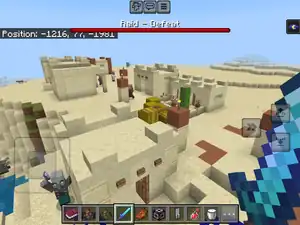
- By downloading worlds from the Marketplace, old and new villagers can be summoned at the same place. Because old villagers don't count as villagers, any raid ends in defeat the moment all new villagers are killed, even if old villagers are still alive.
- The villagers were inspired by the shop keepers in Dungeon Master 2.[3]
- Originally, the mobs populating villages were to be pigmen.[4]
- Villagers tend to often cram into houses that are in the southern-eastern area of their village.
- Name tags used on villagers always name the villager instead of opening the trading interface.
- Villagers can see invisible players.
- After a zombie villager is cured, the villager gets Nausea for 10 seconds (indicated by the purple status effect particles).
- When a villager is in love mode, it walks very slowly. However, when a villager runs indoors as the night falls, it runs extremely fast, even faster than the player's sprinting speed.
- The Horse Update release poster showed a blue-robed villager in the background. Such a villager has never been added to the main game, however a similar design is used for the Scared Villager in Caves & Cliffs Explorers.
- The Priest, Librarian and Nitwit villagers have an unused hood in their textures.
April fools
On April 1, 2014, Mojang announced that villagers have taken over the skin servers and content delivery networks (CDN) as an April Fools joke. This caused players' current skin to turn into villager skins. This also caused users to be unable to change their skins. Different career villager skins were used, including the then-unused nitwit villager (green robe).
Many of the sounds were also changed, supposedly by the villagers. They seem to be similar to a villager talking (with words, rather than their normal sounds). The in-game music has also been altered to include villager like noises, and also features a villager version of the "Game of Thrones" theme on the title screen. The sounds originate from the sound resource pack created by Element Animation, titled The Element Animation Villager Sound Resource Pack (T.E.A.V.S.R.P), which is based on the villagers appearing in their fan videos. The villagers were voiced by Dan Lloyd, Director of Element Animation.
Gallery
Screenshots
-
 Villager in Beta 1.9 Prerelease 1, when villagers had the word "TESTIFICATE" displayed over their heads.
Villager in Beta 1.9 Prerelease 1, when villagers had the word "TESTIFICATE" displayed over their heads. -
 A group of villager children socializing together.
A group of villager children socializing together. -
 A house full of villagers.
A house full of villagers. -
 A villager looking at the player, who is invisible, thus proving that Villagers can see invisible players.
A villager looking at the player, who is invisible, thus proving that Villagers can see invisible players. -
 A villager riding a minecart.
A villager riding a minecart. -
 A priest villager giving bread to a librarian.
A priest villager giving bread to a librarian. -

-
 Purchasing Feather Falling IV enchanted book from a villager before the 1.14 update.
Purchasing Feather Falling IV enchanted book from a villager before the 1.14 update. -
 A baby zombie villager (before 1.9) getting cured.
A baby zombie villager (before 1.9) getting cured. -
 A baby villager cured from being a zombie.
A baby villager cured from being a zombie. -
 A farmer villager running away from a group of burning zombies.
A farmer villager running away from a group of burning zombies. -
 Baby villagers in a butcher shop.
Baby villagers in a butcher shop. -
 The previously-unused Nitwit villager in-game.
The previously-unused Nitwit villager in-game. -
 A villager Texture Update comparison.
A villager Texture Update comparison.
Development screenshots
-
 An image released earlier by Jeb showing separated villagers.
An image released earlier by Jeb showing separated villagers. -

-
 More villagers trapped in holes. There is a creeper in one of the holes.
More villagers trapped in holes. There is a creeper in one of the holes. -
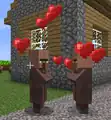 Villagers in love.
Villagers in love.
Textures
-
 Farmer texture
Farmer texture -
 Librarian/cartographer texture
Librarian/cartographer texture -
 Priest texture
Priest texture -
 Blacksmith texture
Blacksmith texture -
 Butcher texture
Butcher texture -
 Nitwit texture
Nitwit texture
Unused Textures
-
 The unused angry villager particle.
The unused angry villager particle. -
 The unused villager speech bubble.
The unused villager speech bubble. -
 An odd combination of Steve and a villager.
An odd combination of Steve and a villager.
Other
-
 An interpretation of what the Steve villager hybrid would look like.
An interpretation of what the Steve villager hybrid would look like.
In other media
-
 The 13w22a Banner.
The 13w22a Banner. -
 Official artwork of a villager.
Official artwork of a villager. -
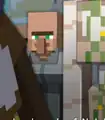 The blue-robed villager found in the 1.6 update poster.
The blue-robed villager found in the 1.6 update poster. -
 Villagers in promotional artwork for the Horse Update.
Villagers in promotional artwork for the Horse Update. -
 Villagers in promotional artwork for the World of Color Update.
Villagers in promotional artwork for the World of Color Update. -
 Villager micromob (right) from Lego Minecraft.
Villager micromob (right) from Lego Minecraft. -
 Lego Minecraft farmer villager minifigure.
Lego Minecraft farmer villager minifigure. -
 Lego Minecraft librarian villager minifigure.
Lego Minecraft librarian villager minifigure. -
 Nurm, a villager featured in Minecraft: Story Mode.
Nurm, a villager featured in Minecraft: Story Mode.
References
- ↑ Categorized as an NPC in the game code.
- ↑ "Meet the Nitwit" – Minecraft.net, January 23, 2017.
- ↑ a b "Meet the Villagers" by Marsh Davies – Minecraft.net, March 13, 2017.
- ↑ http://www.reddit.com/r/Minecraft/comments/xfzdg/i_am_markus_persson_aka_notch_creator_of/c5m0p26
- ↑ https://twitter.com/notch/status/62531431175421952